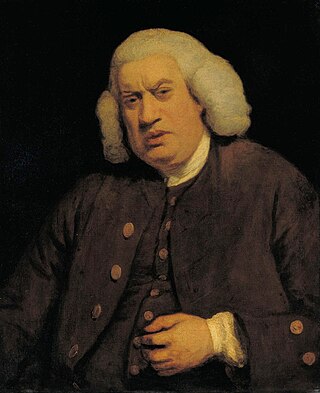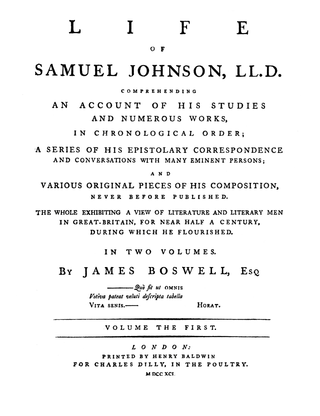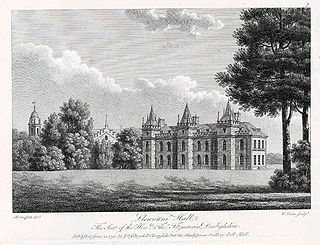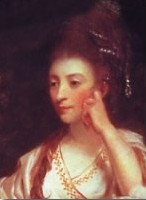
Samuel Johnson, often called Dr Johnson, was an English writer who made lasting contributions as a poet, playwright, essayist, moralist, literary critic, sermonist, biographer, editor, and lexicographer. The Oxford Dictionary of National Biography calls him "arguably the most distinguished man of letters in English history".

Hester Lynch Thrale Piozzi was a Welsh writer and socialite who was an important source on Samuel Johnson and 18th-century British life. She belonged to the prominent Salusbury family of Anglo-Welsh landowners, and married firstly a wealthy brewer, Henry Thrale, with whom she had 12 children, then a music teacher, Gabriel Mario Piozzi. Her Anecdotes of the Late Samuel Johnson (1786) and her diary Thraliana, published posthumously in 1942, are the main works for which she is remembered. She also wrote a popular history book, a travel book, and a dictionary. She has been seen as a protofeminist.

Henry Thrale was a British politician who sat in the House of Commons from 1765 to 1780. He was a close friend of Samuel Johnson. Like his father, he was the proprietor of the large London brewery H. Thrale & Co.

The Life of Samuel Johnson, LL.D. (1791) by James Boswell is a biography of English writer Samuel Johnson. The work was from the beginning a critical and popular success, and represents a landmark in the development of the modern genre of biography. It is notable for its extensive reports of Johnson's conversation. Many have called it the greatest biography written in English, but some modern critics object that the work cannot be considered a proper biography. Boswell's personal acquaintance with his subject began in 1763, when Johnson was 54 years old, and Boswell covered the entirety of Johnson's life by means of additional research. The biography takes many critical liberties with Johnson's life, as Boswell makes various changes to Johnson's quotations and even censors many comments. Nonetheless, the book is valued as both an important source of information on Johnson and his times, as well as an important work of literature.
Sir John Salusbury Piozzi Salusbury was a British civil servant and, briefly, a military officer during the Battle of Waterloo. He was named after his adopted grandfather, Sir John Salusbury.

Lleweni Hall was a stately home in Denbighshire, northeast Wales, around 2 miles (3.2 km) north-east of Denbigh on the banks of the River Clwyd. It was the principal seat of the Salusbury family and their descendants from 1289 until 1748, and the present territorial designation of the most senior branch of the family.
Disjecta: Miscellaneous Writings and a Dramatic Fragment is a collection of previously uncollected writings by Samuel Beckett, spanning his entire career. The title is derived from the Latin phrase "disjecta membra", meaning scattered remains or fragments, usually applied to written work. The essays appear in their original language of composition, as stipulated by Beckett, since the volume is intended for scholars who should be able to read several languages. Beckett himself did not value these pieces much, seeing them as "mere products of friendly obligation or economic need".
The Anecdotes of the Late Samuel Johnson or the Anecdotes of the Late Samuel Johnson, LL.D. During the Last Twenty Years of His Life by Hester Thrale, also known as Hester Lynch Piozzi, was first published 26 March 1786. It was based on the various notes and anecdotes of Samuel Johnson that Thrale kept in her Thraliana. Thrale wrote the work in Italy while she lived there for three years after marrying Gabriel Piozzi.
A Biographical Sketch of Dr Samuel Johnson was written by Thomas Tyers for The Gentleman's Magazine's December 1784 issue. The work was written immediately after the death of Samuel Johnson and is the first postmortem biographical work on the author. The first full length biography was written by John Hawkins and titled Life of Samuel Johnson.

The Plays of William Shakespeare was an 18th-century edition of the dramatic works of William Shakespeare, edited by Samuel Johnson and George Steevens. Johnson announced his intention to edit Shakespeare's plays in his Miscellaneous Observations on Macbeth (1745), and a full Proposal for the edition was published in 1756. The edition was finally published in 1765.
The health of Samuel Johnson has been a focus of the biographical and critical analysis of his life. His medical history was well documented by Johnson and his friends, and those writings have allowed later critics and doctors to infer diagnoses of conditions that were unknown in Johnson's day.

Hester Maria Elphinstone, Viscountess Keith, born Hester Maria Thrale, was a British literary correspondent and intellectual. She was the eldest child of Hester Thrale, diarist, author and confidante of Samuel Johnson, and Henry Thrale, a wealthy brewer and patron of the arts. She became the second wife of George Elphinstone, 1st Viscount Keith.
Samuel Johnson, a British intellectual, wrote dozens of essays that defined his views on the politics of his time.
Robert William Chapman, usually known in print as R. W. Chapman, was a British scholar, book collector and editor of the works of Samuel Johnson and Jane Austen.

William Seward was an English man of letters, known for his collections of anecdotes. he was closely acquainted in London with Samuel Johnson, the Thrales and the Burneys.
Susannah Dobson née Dawson was a translator from the south of England, the daughter of John Dawson of "the parish of St Dunstan, London". She was notably concerned with the 14th-century Italian humanist Petrarch.
Katherine Canby Balderston was an American scholar of 18th century English literature. She was the first female faculty member at Southern Methodist University and later a professor emerita at Wellesley College. She was a winner of the Rose Mary Crawshay Prize in 1941.

According to Queeney is a 2001 Booker-longlisted biographical novel by English writer Beryl Bainbridge. It concerns the last years of Samuel Johnson and his relationship between Hester Thrale and her daughter 'Queeney'. The bulk of the novel is set between 1765 and his death in 1784, with the exception of the correspondence from H. M. Thrale (Queeney) to Laetitia Hawkins from 1807 onwards, at the end of the chapters.
Marianne Francis (1790–1832) was an English evangelical, now known principally as a correspondent of Hester Piozzi and Sarah Wesley. She has been called an "evangelical bluestocking", and is recognised as a significant participant in debate about religious enthusiasm.










